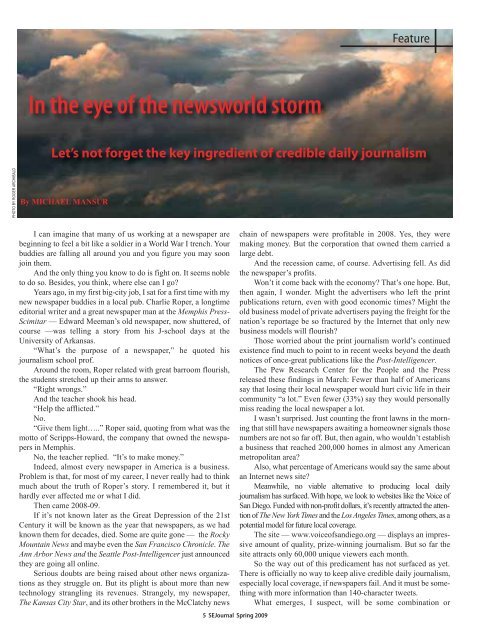SEJ President’s ReportThe world changes and twirls us back toward placeBy CHRISTY GEORGEI’m sure that reading National Geographic in mychildhood laid the groundwork for what I thought wasmy personal theory that geography is destiny.When I visited Central America during the1980’s, I made the connection that, because the regionis constantly rocked by earthquakes and eruptingvolcanoes, the ground beneath peoples’ feet is trulyunstable, and that in turn, has led to Central America’sunstable politics. And later, visiting Japan in the1990’s, I realized the pr<strong>of</strong>ound influence being anisland nation made up <strong>of</strong> overwhelmingly homogenous people hashad in making Japanese culture and politics insular.I was reminded again <strong>of</strong> this theory in January, when SEJ’sboard met at Arizona State University in Phoenix. ASU has both ayoung and rapidly growing Sustainability Institute and a journalismschool — The Walter Cronkite School <strong>of</strong> Journalism and MassCommunication, and SEJers organized a panel on the financialplight <strong>of</strong> journalism. Among the pr<strong>of</strong>essors the “Cronk” hasrecently snared: former CNN anchor Aaron Brown, Steve Doig,late <strong>of</strong> the Miami Herald, former Sacramento Bee editor RickRodriguez, Kristin Gilger <strong>of</strong> the Salem (OR) Statesman-Journaland the Times-Picayune, and new media writer Dan Gillmor, whoditched his column at the San Jose Mercury News to start the firstblog by a mainstream journalist, and who now heads ASU’s KnightCenter for Digital Media Entrepreneurship. The J-school alsodraws heavily on Arizona journalists from all media to be guestlecturers.What was most striking for me was how ASU has grown as aninstitution exactly as the city itself has grown: sprawl. ASU haseven incorporated sprawl into the design <strong>of</strong> its campus andcontent within its Global Institute <strong>of</strong> Sustainability — the first <strong>of</strong>its kind. Director Jonathan Fink told us that the Institute’s foundersliterally gathered up all kinds <strong>of</strong> sustainability-related pieces andprograms and left them in their de-centralized buildings all aroundthe city after the launch. Now, Fink says, ASU treats that organicsprawl as a creative force, encouraging interdisciplinary connectionsand collaborations — notably in the school’s “DecisionTheater,” a laboratory for science-based game-playing and policymakingabout things like pandemic flu.What does all this have to do with environmental journalism?For starters, I’m convinced that an awareness <strong>of</strong> “sense <strong>of</strong> place”adds a deeper dimension to our reporting. What is nature writingif not an exploration <strong>of</strong> very particular places? And I mean naturewriting in the broadest sense, including writing about PCBs, CFCs,or CAFOs.There’s nothing like an SEJ conference, and especially an SEJfield trip, to bring home the connections among a place’s physicalgeography — minerals, trees, plants, animals, birds, fish and bugs,the economy those resources provide to a place, and the cultureand politics <strong>of</strong> a place’s people.Before the age <strong>of</strong> transience arrived and people started4 SEJournal Spring 2009moving several times within their lives, geography wasthe major determinant in our lives: the characteristics <strong>of</strong>the land in our home place shaped the culture we grew upwith, and the local natural resources defined the localeconomy.SEJers discover this every year when the annualconference moves to a new location. This past year, inRoanoke, we encountered Appalachia, a region wheremountains wall <strong>of</strong>f small hollows and separate populationclusters, leading to tightly knit small communities.That isolation produced unique traditional music, crafts, and herbalmedicines, all <strong>of</strong> which endure today. Once the coal companiesmoved in to mine the Appalachian Mountains, people broke theirgeographic isolation by joining the union.Compare Appalachia’s geography to that <strong>of</strong> Madison,Wisconsin, where SEJ will hold our 2009 conference in October.Instead <strong>of</strong> isolated mountain villages, the Midwest is wide, flat andopen, sliced by rivers and dotted with glacial lakes, with smallrounded hills — perfect for raising dairy cattle and growing grain.Grain led to flour mills, and railroads, and manufacturing. Whenpower got overly concentrated in the hands <strong>of</strong> robber baronsduring the Industrial Revolution, workers and farmers in Madison(and across the Midwest) became a hotbed <strong>of</strong> the agrarianProgressive reform movement.This notion that geography is destiny may become even moreimportant as climate change accelerates and the impacts becomemore evident. For one thing, climate change may erode, or evenerase, what we now think <strong>of</strong> as the traditional sense <strong>of</strong> place. Foranother, there could be mass migrations <strong>of</strong> people away from theirtraditional homes to escape intolerable conditions — drought,floods, heat, cold and rising seas. Yet other populations could bestuck in changing places while the natural character <strong>of</strong> those placesthat shaped the local economy and culture disappears.The intersection between a “sense <strong>of</strong> place” and the prospect<strong>of</strong> climate change has spawned new academic experts: biogeographers,paleobiogeographers and cultural biogeographers, whomSEJers can find at http://www.biogeographer.org/ — one <strong>of</strong> manyintriguing sub-groups <strong>of</strong> the Association <strong>of</strong> American Geographers:http://aag.org/sg/sg_display.cfmThanks to climate change, the global economic crisis and,perhaps, the arrival <strong>of</strong> peak oil, the short happy life <strong>of</strong> New YorkTimes columnist Tom Friedman’s “flat world” may come to anabrupt end. If the cost <strong>of</strong> air travel and international shipping risebeyond our means and our super-mobile lifestyle <strong>of</strong> the last halfcenturyends, the world will become very local and very, veryround again. And the job <strong>of</strong> journalists will be to discover the new“sense <strong>of</strong> place” in a transformed world.Christy George, SEJ board president, is special projects producerfor Oregon Public Broadcasting.
FeatureIn the eye <strong>of</strong> the newsworld stormLet’s not forget the key ingredient <strong>of</strong> credible daily journalismPHOTO BY ROGER ARCHIBALDBy MICHAEL MANSURI can imagine that many <strong>of</strong> us working at a newspaper arebeginning to feel a bit like a soldier in a World War I trench. Yourbuddies are falling all around you and you figure you may soonjoin them.And the only thing you know to do is fight on. It seems nobleto do so. Besides, you think, where else can I go?Years ago, in my first big-city job, I sat for a first time with mynew newspaper buddies in a local pub. Charlie Roper, a longtimeeditorial writer and a great newspaper man at the Memphis Press-Scimitar — Edward Meeman’s old newspaper, now shuttered, <strong>of</strong>course —was telling a story from his J-school days at theUniversity <strong>of</strong> Arkansas.“What’s the purpose <strong>of</strong> a newspaper,” he quoted hisjournalism school pr<strong>of</strong>.Around the room, Roper related with great barroom flourish,the students stretched up their arms to answer.“Right wrongs.”And the teacher shook his head.“Help the afflicted.”No.“Give them light…..” Roper said, quoting from what was themotto <strong>of</strong> Scripps-Howard, the company that owned the newspapersin Memphis.No, the teacher replied. “It’s to make money.”Indeed, almost every newspaper in America is a business.Problem is that, for most <strong>of</strong> my career, I never really had to thinkmuch about the truth <strong>of</strong> Roper’s story. I remembered it, but ithardly ever affected me or what I did.Then came 2008-09.If it’s not known later as the Great Depression <strong>of</strong> the 21stCentury it will be known as the year that newspapers, as we hadknown them for decades, died. Some are quite gone — the RockyMountain News and maybe even the San Francisco Chronicle. TheAnn Arbor News and the Seattle Post-Intelligencer just announcedthey are going all online.Serious doubts are being raised about other news organizationsas they struggle on. But its plight is about more than newtechnology strangling its revenues. Strangely, my newspaper,The Kansas City Star, and its other brothers in the McClatchy news5 SEJournal Spring 2009chain <strong>of</strong> newspapers were pr<strong>of</strong>itable in 2008. Yes, they weremaking money. But the corporation that owned them carried alarge debt.And the recession came, <strong>of</strong> course. Advertising fell. As didthe newspaper’s pr<strong>of</strong>its.Won’t it come back with the economy? That’s one hope. But,then again, I wonder. Might the advertisers who left the printpublications return, even with good economic times? Might theold business model <strong>of</strong> private advertisers paying the freight for thenation’s reportage be so fractured by the Internet that only newbusiness models will flourish?Those worried about the print journalism world’s continuedexistence find much to point to in recent weeks beyond the deathnotices <strong>of</strong> once-great publications like the Post-Intelligencer.The Pew Research Center for the People and the Pressreleased these findings in March: Fewer than half <strong>of</strong> Americanssay that losing their local newspaper would hurt civic life in theircommunity “a lot.” Even fewer (33%) say they would personallymiss reading the local newspaper a lot.I wasn’t surprised. Just counting the front lawns in the morningthat still have newspapers awaiting a homeowner signals thosenumbers are not so far <strong>of</strong>f. But, then again, who wouldn’t establisha business that reached 200,000 homes in almost any Americanmetropolitan area?Also, what percentage <strong>of</strong> Americans would say the same aboutan Internet news site?Meanwhile, no viable alternative to producing local dailyjournalism has surfaced. With hope, we look to websites like the Voice <strong>of</strong>San Diego. Funded with non-pr<strong>of</strong>it dollars, it’s recently attracted the attention<strong>of</strong> The New York Times and the Los Angeles Times, among others, as apotential model for future local coverage.The site — www.voice<strong>of</strong>sandiego.org — displays an impressiveamount <strong>of</strong> quality, prize-winning journalism. But so far thesite attracts only 60,000 unique viewers each month.So the way out <strong>of</strong> this predicament has not surfaced as yet.There is <strong>of</strong>ficially no way to keep alive credible daily journalism,especially local coverage, if newspapers fail. And it must be somethingwith more information than 140-character tweets.What emerges, I suspect, will be some combination or












